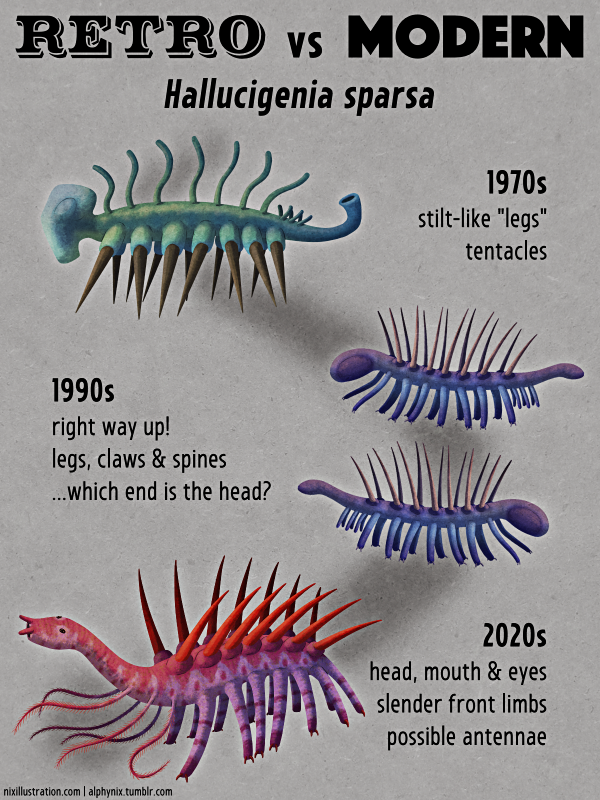If just one single species had to represent how our reconstructions of prehistoric animals can drastically change, it would have to be Hallucigenia sparsa.
1970s
First discovered in the 1910s in the Canadian Burgess Shale fossil deposits, specimens of Hallucigenia were initially categorized as being a species of the early polychaete worm Canadia. It wasn’t until the 1970s that they were recognized as being something else entirely, and the first reconstruction of this tiny animal was bizarre.
It was depicted as a long-bodied creature with a single row of tentacles along its back, and several pairs of long sharp spines that were interpreted as being stilt-like “legs” used to walk. The tentacles were thought to catch food from the water and pass it forwards to the bulbous “head” – and at one point it was even proposed that all the tentacles had their own additional “mouths” at their tips!
It’s easy to look back on this version now and laugh at how ridiculous and obviously wrong it was, but it’s important to remember the historical context here. This was coming from a point when the incredible animal diversity of the Cambrian Explosion was only just starting to be understood, revealing a range of poorly-understood bizarre and alien-looking forms like Opabinia – “weird wonders” that were considered to be representatives of previously unknown ancient branches of life.
At the time, Hallucigenia‘s utter weirdness and impractical body plan seemed to almost make sense as a unique evolutionary “failed experiment” that had left no living relatives.
1990s
Discoveries of legged-and-armored lobopodian “worms” in the Chinese Chengjiang fossil deposits during the 1980s prompted a re-interpretation of Hallucigenia in the early 1990s. Speculatively reconstructing it as a lobopodian with the spines on its back and with the tentacles as a set of paired clawed legs started to make it seem a lot less alien and a lot more like a real velvet-worm-like animal – and just a year later the “missing” other half of the leg pairs was confirmed to be present in some of the fossil specimens.
But it was still unclear which end was actually the head, and whether the large blob-like structure was a real part of Hallucigenia‘s anatomy or just an artifact of the fossilization process.
2020s
New research in the mid-2010s finally settled the head problem and clarified a lot of Hallugicenia‘s anatomy, discovering that the slender elongated end had a pair of simple eyes and a mouth with a throat ringed with tiny teeth.
We now know Hallucigenia sparsa lived all around the world during the mid-Cambrian, about 518-508 million years ago, with body fossils known from Canada and China and isolated spines found in numerous other similarly-aged locations. Instead of an evolutionary dead-end “weird wonder” it was actually an early member of the vast arthropod lineage, just one of a highly diverse collection of successful Cambrian lobopodians, and its closest living relatives are probably velvet worms and tardigrades.
It grew up to about 5cm long (2″) and had seven pairs of long sharp defensive spines along its back, covered with a microscopic surface texture of tiny triangular “scales”. It had seven pairs of clawed walking legs, with most of its feet tipped with two claws each but the final two pairs having just one, and its body ended right at the final pair of limbs – the “blob” structure in some fossils was actually just an artifact the whole time, formed by Halligenia‘s innards being forcefully squeezed out during its burial in the seafloor sediment.
Its neck region bore three pairs of long delicate tendril-like limbs, which may have been covered in feathery hair-like structures for filter-feeding similar to some other lobopodians. A small pair of velvet-worm-like antennae may also have been present on its head, and could have been a sexually dimorphic feature.

